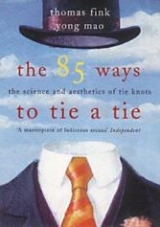
The 85 Ways to Tie a Tie
Encyclopedia
The 85 Ways to Tie a Tie (ISBN 1-84115-249-8) is a book by Thomas Fink
and Yong Mao. The authors were research fellow
s at Cambridge University’s Cavendish Laboratory
. It was published by Fourth Estate on Nov 4, 1999, and subsequently published in nine other languages.
, and how to tie both. It is based on two mathematics papers published by the same authors in the journals Nature
and Physica A. The authors prove there are exactly 85 ways of tying a necktie and enumerates them.
With this shorthand, traditional and new knots can be compactly expressed, as below. Note that any knot that begins with an o move must start with the tie turned inside out around the neck.
, The Daily Telegraph
, The Guardian
, GQ
, Physics World
, and others.
Thomas Fink
Thomas Fink is an Anglo-American physicist who has authored a number of journal articles on statistical and biological physics and two popular books. He is a Chargé de Recherche at CNRS/Institut Curie and when not in Paris lives in London....
and Yong Mao. The authors were research fellow
Research fellow
The title of research fellow is used to denote a research position at a university or similar institution, usually for academic staff or faculty members. A research fellow may act either as an independent investigator or under the supervision of a principal investigator...
s at Cambridge University’s Cavendish Laboratory
Cavendish Laboratory
The Cavendish Laboratory is the Department of Physics at the University of Cambridge, and is part of the university's School of Physical Sciences. It was opened in 1874 as a teaching laboratory....
. It was published by Fourth Estate on Nov 4, 1999, and subsequently published in nine other languages.
The Book
The 85 Ways to Tie a Tie is about the history of the knotted neckcloth, the modern necktieNecktie
A necktie is a long piece of cloth worn for decorative purposes around the neck or shoulders, resting under the shirt collar and knotted at the throat. Variants include the ascot tie, bow tie, bolo tie, and the clip-on tie. The modern necktie, ascot, and bow tie are descended from the cravat. Neck...
, and how to tie both. It is based on two mathematics papers published by the same authors in the journals Nature
Nature (journal)
Nature, first published on 4 November 1869, is ranked the world's most cited interdisciplinary scientific journal by the Science Edition of the 2010 Journal Citation Reports...
and Physica A. The authors prove there are exactly 85 ways of tying a necktie and enumerates them.
The Math
The discovery of all possible ways to tie a tie depends on a mathematical formulation of the act of tying a tie. In their papers (which are technical) and book (which is for a lay audience, apart from an appendix), the authors show that necktie knots are equivalent to persistent random walks on a triangular lattice, with some constraints on how the walks begin and end. Thus enumerating tie knots of n moves is equivalent to enumerating walks of n steps. Imposing the conditions of symmetry and balance reduces the 85 knots to 13 aesthetic ones.Knot Representation
The basic idea is that tie knots can be described as a sequence of six different possible moves, although not all moves can follow each other. These are summarized as follows. All diagrams are as the tie would appear were you wearing it and looking in a mirror.- L: left; C: centre; R: right; these must change every move.
- i: into the diagram; o: out of the diagram; these must alternate.
- T: through the loop just made.
With this shorthand, traditional and new knots can be compactly expressed, as below. Note that any knot that begins with an o move must start with the tie turned inside out around the neck.
Reviews
The book was reviewed in NatureNature (journal)
Nature, first published on 4 November 1869, is ranked the world's most cited interdisciplinary scientific journal by the Science Edition of the 2010 Journal Citation Reports...
, The Daily Telegraph
The Daily Telegraph
The Daily Telegraph is a daily morning broadsheet newspaper distributed throughout the United Kingdom and internationally. The newspaper was founded by Arthur B...
, The Guardian
The Guardian
The Guardian, formerly known as The Manchester Guardian , is a British national daily newspaper in the Berliner format...
, GQ
GQ (magazine)
GQ is a monthly men's magazine focusing on fashion, style, and culture for men, through articles on food, movies, fitness, sex, music, travel, sports, technology, and books...
, Physics World
Physics World
Physics World is the membership magazine of the Institute of Physics, one of the largest physical societies in the world. It is an international monthly magazine covering all areas of physics, both pure and applied, and is aimed at physicists in research, industry and education worldwide...
, and others.
External links
- Thomas Fink's Encyclopedia of Tie Knots

